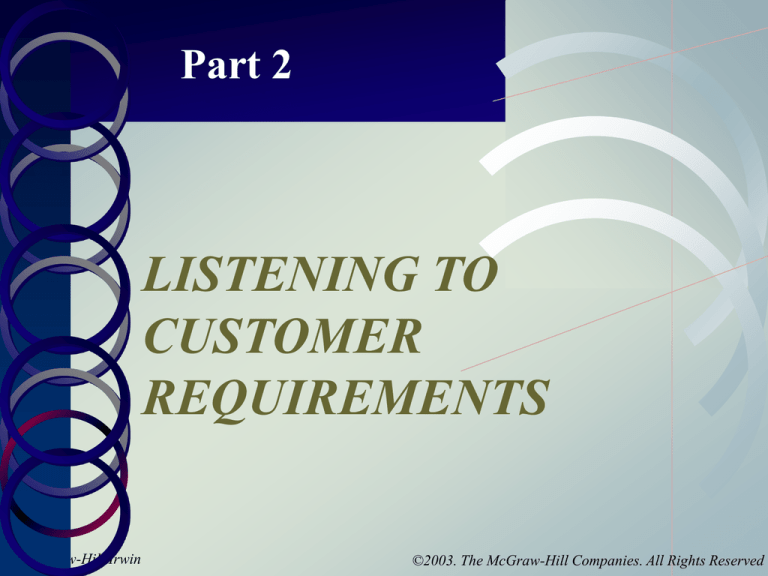
Part 2
LISTENING TO
CUSTOMER
REQUIREMENTS
McGraw-Hill/Irwin
©2003. The McGraw-Hill Companies. All Rights Reserved
Provider GAP 1
CUSTOMER
Expected
Service
GAP 1
COMPANY
Company
Perceptions of
Consumer
Expectations
Part 2 Opener
McGraw-Hill/Irwin
©2003. The McGraw-Hill Companies. All Rights Reserved
Chapter
Understanding Customer
Expectations and Perceptions
Through Marketing Research
5
• Using Marketing Research to Understand
Customer Expectations
• Elements in an Effective Services Marketing
Research Program
• Analyzing and Interpreting Marketing
Research Findings
• Using Marketing Research Information
• Upward Communication
McGraw-Hill/Irwin
©2003. The McGraw-Hill Companies. All Rights Reserved
Objectives for Chapter 5:
Understanding Customer Expectations
and Perceptions through Marketing Research
• Present the types of and guidelines for marketing
research in services.
• Show the ways that marketing research
information can and should be used for services.
• Describe the strategies by which companies can
facilitate interaction and communication between
management and customers.
• Present ways that companies can and do facilitate
interaction between contact people and
management.
McGraw-Hill/Irwin
©2003. The McGraw-Hill Companies. All Rights Reserved
Common Research Objectives
for Services
•
•
•
•
•
•
•
To identify dissatisfied customers
To discover customer requirements or expectations
To monitor and track service performance
To assess overall company performance compared to competition
To assess gaps between customer expectations and perceptions
To gauge effectiveness of changes in service
To appraise service performance of individuals and teams for
rewards
• To determine expectations for a new service
• To monitor changing expectations in an industry
• To forecast future expectations
McGraw-Hill/Irwin
©2003. The McGraw-Hill Companies. All Rights Reserved
Figure 5.1
Criteria for an Effective
Service Research Program
McGraw-Hill/Irwin
©2003. The McGraw-Hill Companies. All Rights Reserved
Portfolio of Services Research
Research Objective
Type of Research
Identify dissatisfied customers to attempt recovery;
identify most common categories of service failure for
remedial action
Customer Complaint
Solicitation
Assess company’s service performance compared to
competitors; identify service-improvement priorities; track
service improvement over time
“Relationship” Surveys
Obtain customer feedback while service experience is still
fresh; act on feedback quickly if negative patterns develop
Post-Transaction Surveys
Use as input for quantitative surveys; provide a forum
for customers to suggest service-improvement ideas
Customer Focus Groups
Measure individual employee service behaviors for use in
coaching, training, performance evaluation, recognition and
rewards; identify systemic strengths and weaknesses in
service
“Mystery Shopping” of
Service Providers
Measure internal service quality; identify employeeperceived obstacles to improve service; track
employee morale and attitudes
Employee Surveys
Determine the reasons why customers defect
Lost Customer Research
To forecast future expectations of customers
To develop and test new service ideas
McGraw-Hill/Irwin
Future Expectations Research
©2003. The McGraw-Hill Companies. All Rights Reserved
Stages in the Research Process
•
•
•
•
•
•
Stage 1 :
Stage 2 :
Stage 3 :
Stage 4 :
Stage 5 :
Stage 6 :
McGraw-Hill/Irwin
Define Problem
Develop Measurement Strategy
Implement Research Program
Collect and Tabulate Data
Interpret and Analyze Findings
Report Findings
©2003. The McGraw-Hill Companies. All Rights Reserved
Figure 5.3
Tracking of Customer Expectations and
Perceptions of Service Reliability
McGraw-Hill/Irwin
©2003. The McGraw-Hill Companies. All Rights Reserved
Figure 5.4
Service Quality Perceptions
Relative to Zones of Tolerance
(by Dimensions)
9
8
7
O
6
O
O
O
O
5
4
3
2
1
0
Reliability
Retail Chain
McGraw-Hill/Irwin
Responsiveness
Assurance
Empathy
Tangibles
= Zone of Tolerance O = S.Q. Perception
©2003. The McGraw-Hill Companies. All Rights Reserved
Service Quality Perceptions
Relative to Zones of Tolerance
(by Dimensions)
10
8
O
O
O
O
O
6
4
2
0
Reliability
Responsiveness
Computer
Manufacturer
McGraw-Hill/Irwin
Assurance
Empathy
= Zone of Tolerance
Tangibles
O = S.Q. Perception
©2003. The McGraw-Hill Companies. All Rights Reserved
Figure 5.5
Importance/Performance Matrix
Importance
HIGH
High
Leverage
Attributes to Improve
Attributes to Maintain
Low
Leverage
Attributes to Maintain
LOW
McGraw-Hill/Irwin
Attributes to De-emphasize
Performance
HIGH
©2003. The McGraw-Hill Companies. All Rights Reserved





